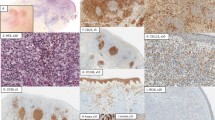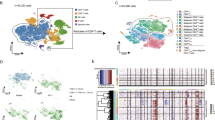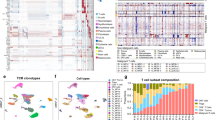Abstract
Cutaneous T-cell lymphomas (CTCL) are mainly comprised of two variants: mycosis fungoides (MF) with CD4+ tumor cells confined to the skin and the leukemic Sézary syndrome with tumor cell spread to the blood. In this study, we investigated cutaneous expression of the regulatory T-cell (Treg) marker FOXP3 in 30 CTCL patients. Immunohistochemical analysis revealed significantly lower numbers of CD4+FOXP3+ cells within the dermal lymphomononuclear infiltrate of Sézary patients (16% FOXP3+ cells of CD4+ cells) in contrast to MF (43% FOXP3+ cells (P<0.05)) and rare types of CTCL (45% FOXP3+ cells). Furthermore, CD4+FOXP3+ T cells were also markedly reduced in the CD4+ population within the peripheral blood of Sézary patients compared to controls as determined by fluorescence-activated cell sorter, quantitative PCR and functional analyses. The data support the conclusion that the neoplastic cells in CTCL do not express the Treg marker FOXP3. Our data also identify Sézary syndrome as, to our knowledge, the first reported neoplastic disease with a clear reduction in Treg numbers within the CD4+ population. This lack of Treg might account for the more aggressive nature of Sézary syndrome compared with other CTCL.
This is a preview of subscription content, access via your institution
Access options
Subscribe to this journal
Receive 12 print issues and online access
$259.00 per year
only $21.58 per issue
Buy this article
- Purchase on Springer Link
- Instant access to full article PDF
Prices may be subject to local taxes which are calculated during checkout




Similar content being viewed by others
References
Willemze R, Jaffe ES, Burg G, Cerroni L, Berti E, Swerdlow SH et al. WHO-EORTC classification for cutaneous lymphomas. Blood 2005; 105: 3768–3785.
Dippel E, Klemke CD, Goerdt S . Current status of cutaneous T-cell lymphoma: molecular diagnosis, pathogenesis, therapy and future directions. Onkologie 2003; 26: 477–483.
Vonderheid EC, Bernengo MG, Burg G, Duvic M, Heald P, Laroche L et al. Update on erythrodermic cutaneous T-cell lymphoma: report of the International Society for Cutaneous Lymphomas. J Am Acad Dermatol 2002; 46: 95–106.
Vowels BR, Cassin M, Vonderheid EC, Rook AH . Aberrant cytokine production by Sezary syndrome patients: cytokine secretion pattern resembles murine Th2 cells. J Invest Dermatol 1992; 99: 90–94.
Dummer R, Dobbeling U, Geertsen R, Willers J, Burg G, Pavlovic J . Interferon resistance of cutaneous T-cell lymphoma-derived clonal T-helper 2 cells allows selective viral replication. Blood 2001; 97: 523–527.
Jones D, Ibrahim S, Patel K, Luthra R, Duvic M, Medeiros LJ . Degree of CD25 expression in T-cell lymphoma is dependent on tissue site: implications for targeted therapy. Clin Cancer Res 2004; 10: 5587–5594.
French LE, Huard B, Wysocka M, Shane R, Contassot E, Arrighi JF et al. Impaired CD40L signaling is a cause of defective IL-12 and TNF-alpha production in Sezary syndrome: circumvention by hexameric soluble CD40L. Blood 2005; 105: 219–225.
Berger CL, Tigelaar R, Cohen J, Mariwalla K, Trinh J, Wang N et al. Cutaneous T-cell lymphoma: malignant proliferation of T-regulatory cells. Blood 2005; 105: 1640–1647.
Hori S, Nomura T, Sakaguchi S . Control of regulatory T cell development by the transcription factor Foxp3. Science 2003; 299: 1057–1061.
Suri-Payer E, Amar AZ, Thornton AM, Shevach EM . CD4+CD25+ T cells inhibit both the induction and effector function of autoreactive T cells and represent a unique lineage of immunoregulatory cells. J Immunol 1998; 160: 1212–1218.
Kohno T, Yamada Y, Akamatsu N, Kamihira S, Imaizumi Y, Tomonaga M et al. Possible origin of adult T-cell leukemia/lymphoma cells from human T lymphotropic virus type-1-infected regulatory T cells. Cancer Sci 2005; 96: 527–533.
Baecher-Allan C, Wolf E, Hafler DA . Functional analysis of highly defined, FACS-isolated populations of human regulatory CD4+ CD25+ T cells. Clin Immunol 2005; 115: 10–18.
Fritzsching B, Oberle N, Eberhardt N, Quick S, Haas J, Wildemann B et al. In contrast to effector T cells, CD4+CD25+FoxP3+ regulatory T cells are highly susceptible to CD95 ligand- but not to TCR-mediated cell death. J Immunol 2005; 175: 32–36.
Poenitz N, Dippel E, Klemke CD, Qadoumi M, Goerdt S . Jessner's lymphocytic infiltration of the skin: a CD8+ polyclonal reactive skin condition. Dermatology 2003; 207: 276–284.
Roncador G, Brown PJ, Maestre L, Hue S, Martinez-Torrecuadrada JL, Ling KL et al. Analysis of FOXP3 protein expression in human CD4+CD25+ regulatory T cells at the single-cell level. Eur J Immunol 2005; 35: 1681–1691.
Djemadji-Oudjiel N, Goerdt S, Kodelja V, Schmuth M, Orfanos CE . Immunohistochemical identification of type II alternatively activated dendritic macrophages (RM 3/1+3, MS-1+/−, 25F9−) in psoriatic dermis. Arch Dermatol Res 1996; 288: 757–764.
Schmitz I, Weyd H, Krueger A, Baumann S, Fas SC, Krammer PH et al. Resistance of short term activated T cells to CD95-mediated apoptosis correlates with de novo protein synthesis of c-FLIPshort. J Immunol 2004; 172: 2194–2200.
Igney FH, Behrens CK, Krammer PH . The influence of CD95L expression on tumor rejection in mice. Eur J Immunol 2003; 33: 2811–2821.
Dippel E, Assaf C, Hummel M, Schrag HJ, Stein H, Goerdt S et al. Clonal T-cell receptor gamma-chain gene rearrangement by PCR-based GeneScan analysis in advanced cutaneous T-cell lymphoma: a critical evaluation. J Pathol 1999; 188: 146–154.
Trainor KJ, Brisco MJ, Wan JH, Neoh S, Grist S, Morley AA . Gene rearrangement in B- and T-lymphoproliferative disease detected by the polymerase chain reaction. Blood 1991; 78: 192–196.
Assaf C, Hummel M, Dippel E, Goerdt S, Muller HH, Anagnostopoulos I et al. High detection rate of T-cell receptor beta chain rearrangements in T-cell lymphoproliferations by family specific polymerase chain reaction in combination with the GeneScan technique and DNA sequencing. Blood 2000; 96: 640–646.
Klemke CD, Dippel E, Dembinski A, Ponitz N, Assaf C, Hummel M et al. Clonal T cell receptor gamma-chain gene rearrangement by PCR-based GeneScan analysis in the skin and blood of patients with parapsoriasis and early-stage mycosis fungoides. J Pathol 2002; 197: 348–354.
Curiel TJ, Coukos G, Zou L, Alvarez X, Cheng P, Mottram P et al. Specific recruitment of regulatory T cells in ovarian carcinoma fosters immune privilege and predicts reduced survival. Nat Med 2004; 10: 942–949.
Viguier M, Lemaitre F, Verola O, Cho MS, Gorochov G, Dubertret L et al. Foxp3 expressing CD4+CD25(high) regulatory T cells are overrepresented in human metastatic melanoma lymph nodes and inhibit the function of infiltrating T cells. J Immunol 2004; 173: 1444–1453.
Zola H . Markers of cell lineage, differentiation and activation. J Biol Regul Homeost Agents 2000; 14: 218–219.
Sugiyama H, Gyulai R, Toichi E, Garaczi E, Shimada S, Stevens SR et al. Dysfunctional blood and target tissue CD4+CD25high regulatory T cells in psoriasis: mechanism underlying unrestrained pathogenic effector T cell proliferation. J Immunol 2005; 174: 164–173.
Bovenschen HJ, Seyger MM, Van De Kerkhof PC . Plaque psoriasis vs atopic dermatitis and lichen planus: a comparison for lesional T-cell subsets, epidermal proliferation and differentiation. Br J Dermatol 2005; 153: 72–78.
Cao D, van Vollenhoven R, Klareskog L, Trollmo C, Malmstrom V . CD25brightCD4+ regulatory T cells are enriched in inflamed joints of patients with chronic rheumatic disease. Arthritis Res Ther 2004; 6: R335–R346.
Belkaid Y, Piccirillo CA, Mendez S, Shevach EM, Sacks DL . CD4+CD25+ regulatory T cells control Leishmania major persistence and immunity. Nature 2002; 420: 502–507.
Ou LS, Goleva E, Hall C, Leung DY . T regulatory cells in atopic dermatitis and subversion of their activity by superantigens. J Allergy Clin Immunol 2004; 113: 756–763.
Viglietta V, Baecher-Allan C, Weiner HL, Hafler DA . Loss of functional suppression by CD4+CD25+ regulatory T cells in patients with multiple sclerosis. J Exp Med 2004; 199: 971–979.
Yu P, Lee Y, Liu W, Krausz T, Chong A, Schreiber H et al. Intratumor depletion of CD4+ cells unmasks tumor immunogenicity leading to the rejection of late-stage tumors. J Exp Med 2005; 201: 779–791.
Maeda A, Schwarz A, Kernebeck K, Gross N, Aragane Y, Peritt D et al. Intravenous infusion of syngeneic apoptotic cells by photopheresis induces antigen-specific regulatory T cells. J Immunol 2005; 174: 5968–5976.
Alvaro T, Lejeune M, Salvado MT, Bosch R, Garcia JF, Jaen J et al. Outcome in Hodgkin's lymphoma can be predicted from the presence of accompanying cytotoxic and regulatory T cells. Clin Cancer Res 2005; 11: 1467–1473.
Roncador G, Garcia JF, Garcia JF, Maestre L, Lucas E, Menarguez J et al. FOXP3, a selective marker for a subset of adult T-cell leukaemia/lymphoma. Leukemia 2005; 19: 2247–2253.
Acknowledgements
We thank Cornelius Fritsch and Dr Karsten Gülow for critical reading of the manuscript, Manuel Scheuermann and Klaus Hexel for technical assistance, Sayran Arif-Said and Jutta Mohr for excellent support with immunohistochemistry and Dr Lutz Edler for statistical analysis. This work was supported by grants from the Deutsche Forschungsgemeinschaft (SFB 405) to CDK and a Heisenberg professorship to AK (KU 1559/1-1), the Deutsche Krebshilfe to PHK and the Young Investigator Award of the Faculty of Medicine, University of Heidelberg to BFritzsching, NO was supported by the Landesstiftung Baden-Württemberg and AHB by the Leukemia Research Fund.
Author information
Authors and Affiliations
Corresponding author
Additional information
Supplementary Information accompanies the paper on the Leukemia website (http://www.nature.com/leu)
Rights and permissions
About this article
Cite this article
Klemke, CD., Fritzsching, B., Franz, B. et al. Paucity of FOXP3+ cells in skin and peripheral blood distinguishes Sézary syndrome from other cutaneous T-cell lymphomas. Leukemia 20, 1123–1129 (2006). https://doi.org/10.1038/sj.leu.2404182
Received:
Revised:
Accepted:
Published:
Issue Date:
DOI: https://doi.org/10.1038/sj.leu.2404182
Keywords
This article is cited by
-
Staphylococcus aureus enterotoxins induce FOXP3 in neoplastic T cells in Sézary syndrome
Blood Cancer Journal (2020)
-
Analysis of FOXP3+ regulatory T cell subpopulations in peripheral blood and tissue of patients with systemic lupus erythematosus
Immunologic Research (2017)
-
Peripheral T cell lymphoma with a regulatory T cell phenotype: a Mexican case not associated with HTLV-1 virus infection
Journal of Hematopathology (2014)
-
Regulatory T cells and immunodeficiency in mycosis fungoides and Sézary syndrome
Leukemia (2012)
-
Dynamic changes in cellular infiltrates with repeated cutaneous vaccination: a histologic and immunophenotypic analysis
Journal of Translational Medicine (2010)



